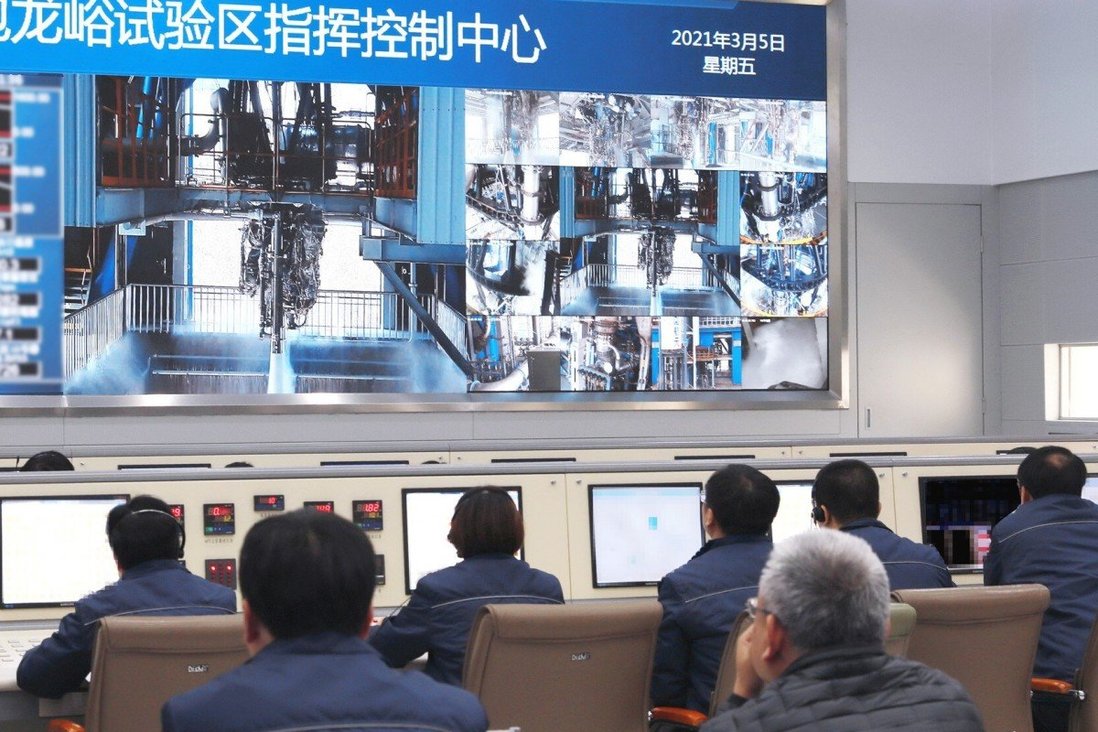China super rocket engine passes early test with successful trial
- The engine’s 500-tonne thrust is being developed for ambitious space missions, including a manned trip to Mars
- New engine is designed to power China’s next generation Long March 9 with first flight expected in 2030
Liu Zhen in Beijing
Published: 12:00am, 7 Mar, 2021

The 500-tonne-thrust liquid oxygen and kerosene engine is designed for the next generation carrier rocket Long March 9 (CZ-9), which is expected to make its first flight in 2030. Photo: Handout
China on Friday conducted a successful trial run of a super heavy-lift rocket engine that quadruples its current power and would place it among the world’s most powerful liquid fuel engines, making future grand space missions possible.
The 500-tonne-thrust engine passed a “half-system on full working condition” trial by developer China Aerospace Science and Technology Corporation (CASC) in the northwestern province of Shaanxi, according to state media reports.
“In the trial run the start-up, shifting gear, changing conditions and shutdown procedures all went smoothly, which validated the plans for the engine design, manufacturing and test, and laid the foundation for the next whole-system trial and other development work,” said CASC, China’s state-owned main contractor for its space programmes.
The liquid oxygen (LOX) and kerosene engine is designed for the next-generation carrier rocket Long March 9 (CZ-9), which is expected to make its first flight in 2030.
As the world’s largest twin-tube thrust chamber engine, it provides four times the thrust of the country’s most powerful engine, the YF-100 – a 120-tonne-thrust LOX kerosene high-pressure staged combustion engine that drives most of China’s rockets, including the heaviest-lift Long March 5 (CZ-5).
The CZ-5 is suitable for missions in the pipeline including the building of the Tiangong space station and the next few Chang’e missions to the moon, but a more powerful launch vehicle would be needed for some other projects under discussion.
Beijing is considering establishing an international lunar research station with Russia and sending humans to Mars.
Last week, Wu Yanhua, vice-director of the China National Space Administration, confirmed on state television that the CZ-9 project was under way for manned missions to the moon and Mars.
The CZ-9 is expected to be able to lift up to 140 tonnes to low-Earth orbit (LEO) or 50 tonnes to trans-lunar injection, compared to the CZ-5’s maximum capacity of 25 tonnes to LEO.
In addition to the 500-tonne-thrust LOX kerosene engine just tested, the CZ-9 will also need a 220-tonne-thrust liquid oxygen-liquid hydrogen staged combustion cycle engine for the second stage of future missions.
China’s most powerful current LOX hydrogen engine, the YF-77, has a 70-tonne thrust, but its difficult development delayed the progress of CZ-5 missions.
Meanwhile, rocket scientist Jiang Jie – who is taking part in the annual session
of the country’s highest political advisory body the Chinese People’s Political Consultative Conference – said on Wednesday that another new super heavy-lift carrier rocket was in development, in parallel with the CZ-9.
This “new-generation crew launch vehicle” would be based on the cores of the CZ-5 and upgraded versions of the YF-100, he said.
“The successful development of these two types of rockets will greatly enhance the ability of our spacecraft to enter outer space.”
China’s space missions for 2021 to 2025 are detailed in the country’s next five-year plan which will be reviewed and approved next week during annual session of the National People’s Congress.